ENDEAVOUR EXTENDS MINERALIZATION AT ITS THREE RECENT DISCOVERIES AT HOUNDÉ
Maiden resource at Kari West and Kari Center discoveries expected in Q4-2019 · Further extensions defined at Kari Pump
View News Release in PDF Format
HOUNDÉ EXPLORATION UPDATE:
- Over 104,000m drilled over the large Kari gold-in-soil anomaly since late 2018, totalling over 300,000m since drilling began in 2017
- Highly successful drill program with low expected discovery cost as approximately 85% of holes encountered meaningful mineralization
- Mineralization has been significantly extended at all three discoveries made in the Kari area:
- Kari Pump (where a 0.7Moz at 3.01 g/t Au reserve was recently delineated) near-surface mineralization was extended 700m to the northeast and 900m towards Kari West, and remains open
- Kari Center was significantly extended and is now composed of two mineralized zones:
- The previously discovered zone now extends 1,300m along strike and 300m wide, and remains open at depth and to the east towards Kari Pump
- The newly discovered zone extends 2,100m along strike and across a width of over 400m and remains open at depth and to the south
- Kari West now extends over an area 1,000m long by 500m wide, and remains open at depth and to the east towards Kari Pump
- A further 90,000m drilling campaign is underway with the aim of delineating a maiden resource and reserve for the Kari West and Kari Center discoveries in Q4-2019
Abidjan, July 2, 2019 – Endeavour Mining (TSX:EDV)(OTCQX:EDVMF) is pleased to announce that an ongoing exploration program at its Houndé mine in Burkina Faso has significantly extended mineralization at all three discoveries in the Kari area, boosting confidence that maiden resources will be delineated before year-end.
The Kari anomaly, which now extends over a very large area measuring 6km long and 3km wide, hosts three recent discoveries (Kari Pump, Kari West and Kari Center) with approximately 25% of the target still to be drilled. A total of 1,027 holes comprising 104,000 meters have been drilled since November 2018 over the large Kari gold in soil anomaly, totalling over 300,000 meters since drilling began in 2017. The ongoing exploration program has continued to be highly successful as approximately 85% of holes drilled encountered meaningful mineralization, resulting in the extension of all three discoveries made in the Kari area.
Patrick Bouisset, Executive President Exploration and Growth stated: “With more than half of the 2019 planned 195,000-meter drilling program completed to date, we are extremely pleased with the results as they have significantly extended the footprint of the three Kari discoveries. Moreover, these results boost our confidence that maiden resources will be delineated for Kari West and Kari Center before year-end. We look forward to continuing to build on our recent value creation success, as noted with the recently published maiden reserve at Kari Pump which was discovered at a cost of less than $13.50/oz of reserve.”
ABOUT THE KARI AREA EXPLORATION PROGRAM
As shown in Figure 1 below, the Kari area is a large gold-in-soil anomaly which covers an area 6km-long by 3km-wide, and located 7km northwest of the Houndé processing plant. The area has been the focus of extensive exploration activity since 2017, with over 300,000 meters drilled and three discoveries made: Kari Pump (for which a maiden resource and reserve was recently delineated), and Kari Center and Kari West (for which a maiden resource is expected to be published by year-end).
Figure 1 - Simplified Houndé Exploration Targets Map
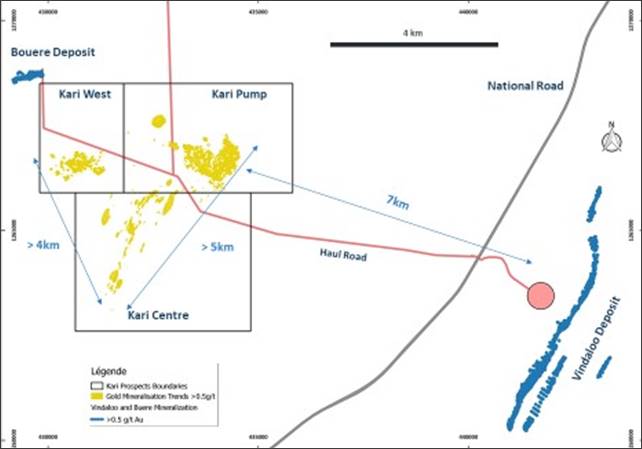
Following the successful 2017 and 2018 campaigns, another aggressive 195,000-meter drilling program with a budget of $17 million, began in January 2019, focusing on extending the mineralization of Kari Pump and delineating a maiden resource for both the Kari West and Kari Center discoveries. To date 1,027 holes were drilled totalling 104,179 meters, as demonstrated in Figure 2 and summarized in Table 1 below.
Figure 2 - Kari Area 2019 Drilling
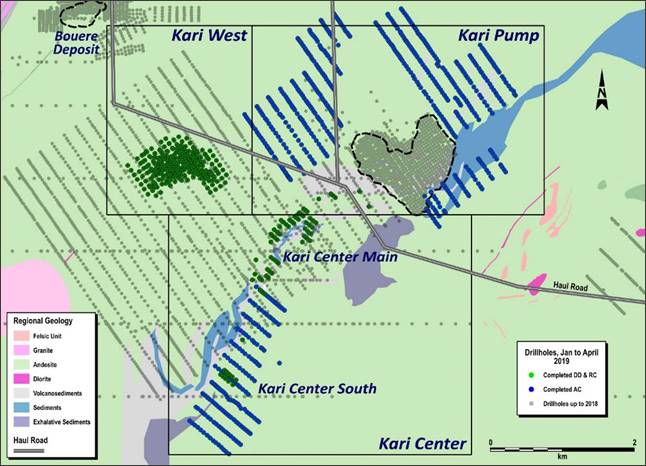
Table 1 - Summary of 2019 Kari Area Drilling Program
| | AIR CORE
(“AC”) | | DIAMOND DRILLING
(“DD”) | | REVERSE CIRCULATION
(“RC”) | | TOTAL |
| | Holes | Meters | | Holes | Meters | | Holes | Meters | | Holes | Meters |
| Kari Pump | 508 | 36,343 | | - | - | | - | - | | 508 | 36,343 |
| Kari Center | 175 | 13,876 | | 19 | 3,882 | | 54 | 9,310 | | 248 | 27,068 |
| Kari West | - | - | | 10 | 2,083 | | 261 | 38,685 | | 271 | 40,768 |
| Total | 683 | 50,219 | | 29 | 5,965 | | 315 | 47,995 | | 1,027 | 104,179 |
The ongoing exploration program has continued to be highly successful where approximately 85% of the holes drilled have encountered at least one interval of mineralization of 0.5 g/t Au with a minimum width of more than two meters.
- Near-surface mineralization at the Kari Pump deposit was extended 700 meters to the northeast and 900 meters towards Kari West and remains open.
- Kari Center has also been significantly extended and is now composed of two mineralized zones, named South and Main. The previously discovered Main zone now extends 1,300 meters along strike and is 300-meter wide, and remains open at depth and to the east towards Kari Pump. The newly discovered South zone extends 2,100 meters along strike and across a width of over 400 meters and remains open at depth and to the south.
- Lastly, Kari West now extends over an area 1,000 meters long by 500 meters wide, and remains open at depth and to the east towards Kari Pump.
As shown in Figure 3 below, the Kari Center and Kari West discoveries are located in close proximity to Kari Pump and more drilling is required to determine a possible geological link between the discoveries.
Figure 3 - Simplified Houndé Mineralization Map
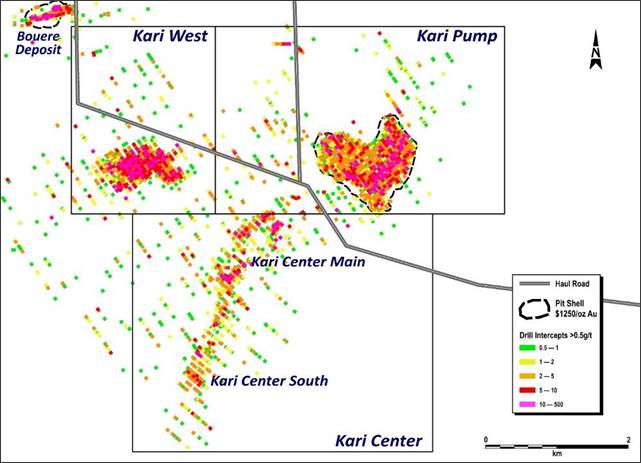
KARI PUMP EXTENSION DRILLING
Drilling campaigns in 2017 and 2018 successfully delineated the Kari Pump maiden resource and related reserves over an area 1,300 meters long by 800 meters wide, with mineralization open towards the northwest, northeast, east and south. The ongoing 2019 drilling campaign is focused on testing the extensions of the Kari Pump mineralization, as illustrated in Figure 4 below with Zones A, B, C, and D.
Figure 4 - Kari Pump Extension Drilling and Selected Intercepts
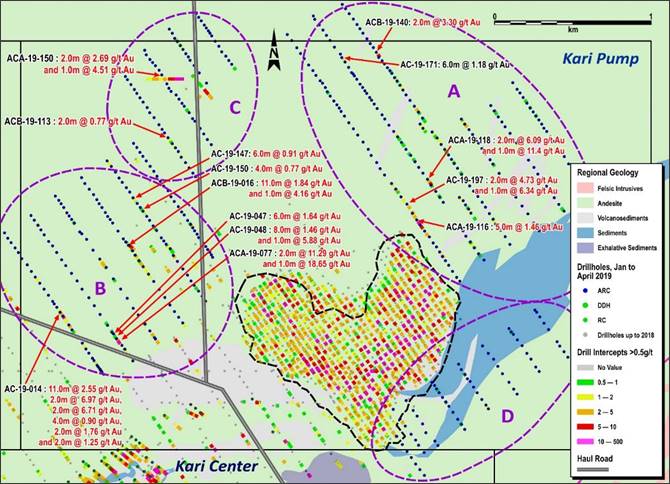
A total of 508 AC holes for 36,343 meters have been drilled since the start of the year, confirming strong mineralization in Zones A and B, and to a lesser extent in Zone C, while drilling in Zone D indicated that mineralization is closed in the southeast direction. Due to the positive results from the shallow holes drilled, a follow-up drilling program is planned for Zones A, B and C later this year.
Drilling in Zone A successfully intercepted shallow gold mineralization extending 700 meters away from Kari Pump in a north-northeast direction, open to the northeast.
Reconnaissance lines in Zone B intercepted gold mineralization extending 900 meters away from Kari Pump in a west-northwest direction. This later trend may represent a mineralized link with Kari West.
Selected intersects include (apparent thickness, uncapped):
Zone A:
- ACA-19-118: 2.0m at 6.09 g/t Au and 1.0m at 11.40 g/t Au
- AC-19-197: 2.0m at 4.73 g/t Au and 1.0m at 6.34 g/t Au
- ACA-19-116: 5.0m at 1.46 g/t Au
- ACB-19-140: 2.0m at 3.30 g/t Au
Zone B:
- AC-19-014: 11.0m at 2.55 g/t Au, 2.0m at 6.97 g/t Au, 2.0m at 6.71 g/t Au, 4.0m at 0.90 g/t Au, 2.0m at 1.76 g/t Au, and 2.0m at 1.25 g/t Au
- ACA-19-077: 2.0m at 11.29 g/t Au and 1.0m at 18.65 g/t Au
- ACB-19-016: 11.0m at 1.84 g/t Au and 1.0m at 4.16 g/t Au
- AC-19-047: 6.0m at 1.64 g/t Au
Most of the 2019 AC holes were drilled to terminate in fresh rock. Geologic logging of the chips indicates a similar lithologic sequence to that at Kari Pump, with intermediate volcanic rocks (andesites, reworked volcanic products-epiclastite, cinerite, coarse debris flow, greywacke) and minor intercalated volcano-sediments and sediments (pelites, black shales). As per the Kari Pump Main area, a complex network of quartz veins within a pervasive silica-sericite-Albite ± Py alteration hosts gold mineralization.
KARI CENTER
The 2018 drill program led to the Kari Center discovery with high-grade intersections and proven continuity towards the southwest. To date, the 2019 drilling campaign has significantly extended the discovery towards the southwest. Kari Center is now divided into two continuous mineralized trends, each with characteristic trends and dips.
- At Kari Center Main, discovered in 2018, mineralization trends east to northeast and dips moderately-steeply towards the northwest. The zone now covers an area approximately 1,300 meters along strike at a width of approximately 300 meters and is open at depth and towards Kari Pump.
- At the newly discovered Kari Center South, mineralization trends north to northeast and dips moderately to the west. This new mineralized trend is still sparsely recognized by drilling, but already covers an area approximately 2,100 meters along strike at a width of approximately 400 meters. It is open at depth and to the south.
Figure 5 - Kari Center Main and South with Selected Intercepts
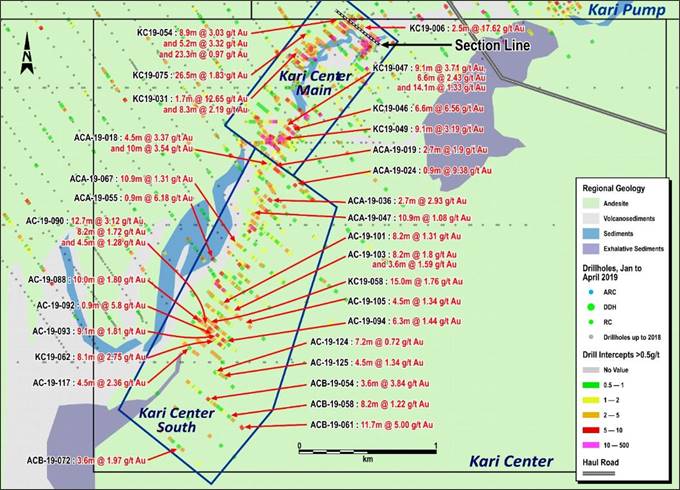
Selected best intersects include (apparent thickness, uncapped):
Kari Center Main:
- KC19-006: 2.5m at 17.62 g/t Au
- KC19-046: 6.6m at 6.56 g/t Au (including 3.3m at 11.64 g/t Au from 9.00m)
- KC19-047: 9.1m at 3.71 g/t Au
- KC19-049: 9.1m at 3.19 g/t Au
- KC19-054: 8.9m at 3.03 g/t Au
Kari Center South:
- KC19-058: 13.6m at 1.76 g/t Au
- KC19-062: 8.2m at 2.75 g/t Au
As shown in Figure 6 below, mafic volcanics with intercalated volcano sediments and subordinate tuffaceous and clastic units predominantly underlie the discoveries in the broader Kari Center area. Towards the southeast, the volcanic units transition sharply to a predominantly sedimentary unit comprising intercalated centimetric bands of greywackes, siltites and carbonaceous (locally graphitic) pelites around the contact. The southern mineralized pattern seems to correlate with regional N20° deep structure corridors, possibly offering exploration upside as the structures repeat at intervals along this lithological contact. In general, the lithologic units reflect lower greenschist facies level of metamorphism.
Allochthonous laterite dominates the slopes of topographically elevated areas often masking underlying weathering and mineralization. In Kari Center, weathering is intense and deep, often reaching 110-meter depth at Kari Center Main and 60 meters at Kari Center South.
A sericite-albite-silica+/-pyrite alteration of variable intensity occurs across all lithologic units but is most strongly developed in volcanic and tuffaceous units where it imparts a light grey “bleach’ to the rocks. The strong alteration is associated with gold mineralization, and it may be very similar to the sericite+/-silica +/- pyrite observed at Kari West. At Kari Center Main, the mineralization forms a 25 meter thick corridor within the alteration envelope, forming possibly two trends approximately 150 meters apart.
Gold mineralization is associated with the pyrite and silica within the alteration package. Mineralized quartz veins exhibit haloes of silica-albite-sericite-pyrite alteration. To date, neither visible gold nor arsenopyrite have been observed in drill cuttings.
For a better understanding of the geological model, the overall mineralization and structural context is being tested with oriented core diamond drilling.
Figure 6 - Kari Center Main Section

KARI WEST
Kari West was also discovered in 2018 during the aggressive Air Core drilling program aimed at evaluating the strong gold-in-soil geochemical anomalies over the Kari area. In 2019, follow-up RC drilling has successfully delineated and defined a mineralized area of at least 1,000 meters in strike length at a width of approximately 500 meters, as shown in Figure 7 below. Kari West remains open at depth and to the east towards Kari Pump.
Figure 7 - Kari West Drill Map with Selected Intercepts
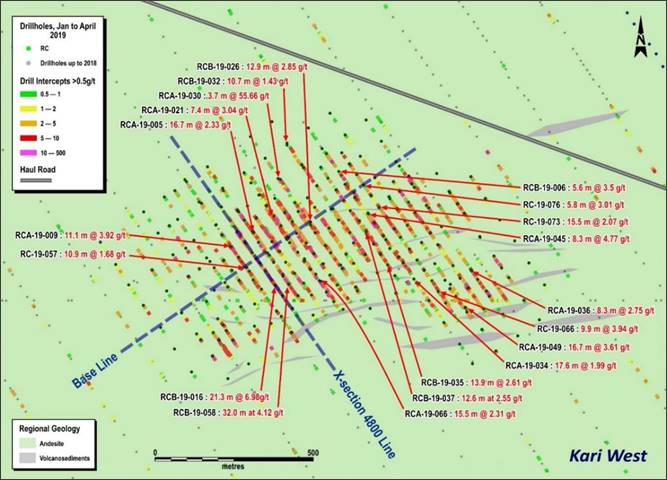
Selected intersections include (true thickness, uncapped):
- RC-19-088R: 12.6m at 5.14 g/t Au (including 1.94m at 9.72 g/t Au)
- RCA-19-009: 11.1m at 3.92 g/t Au (including 1.85m at 5.60 g/t Au)
- RCB-19-016: 21.3m at 6.98 g/t Au (including 1.94m at 32.25 g/t Au)
- RCB-19-049: 22.3m at 3.82 g/t Au (including 0.97m at 24.00 g/t Au)
- RCB-19-058: 21.3m at 2.12 g/t Au and 32.0m at 4.12 g/t Au
Mafic volcanics with subordinate tuffaceous units and minor fine-grained volcano-sedimentary units underly the Kari West discovery. In general, the units reflect lower greenschist facies level of metamorphism, trend east-northeast and dip shallowly-moderately towards the north. Weathered bedrock and saprolite development vary between 25 meters and 75 meters thick with thicker zones observed further to the south, proximal to a zone hosting more numerous intercalated volcano-sedimentary units. Laterite up to 20 meters thick covers most of the Kari West area.
A zone of alteration characterized by a sericite+/-silica +/- pyrite mineral assemblage with variable intensity and colour with localized cores of stronger, texturally destructive silica-albite-sericite-pyrite+/-hematite alteration occupies the center of the deposit. The alteration extends approximately 300-meter wide with an east-northeast trend and open at depth. Gold mineralization is associated with the pyrite and silica within the alteration package. Mineralized quartz veins exhibit haloes of rose-coloured silica-albite-sericite-pyrite alteration. To date, like in Kari Center, neither visible gold nor arsenopyrite have been observed in drill cuttings.
Preliminary interpretation suggests an overall average east-northeast trend of mineralization, which dips shallowly to the north-northwest. Some geologic cross sections also suggest a steeper dipping mineralized zone possibly associated with thicker and higher-grade intercepts. These steeper dipping zones are up to 80 meters wide and may represent core areas of the global mineralized system. The overall geologic, mineralization and structural context is yet to be fully understood and it is currently being tested with oriented core diamond drilling.
Figure 8 - Kari West Drill Section
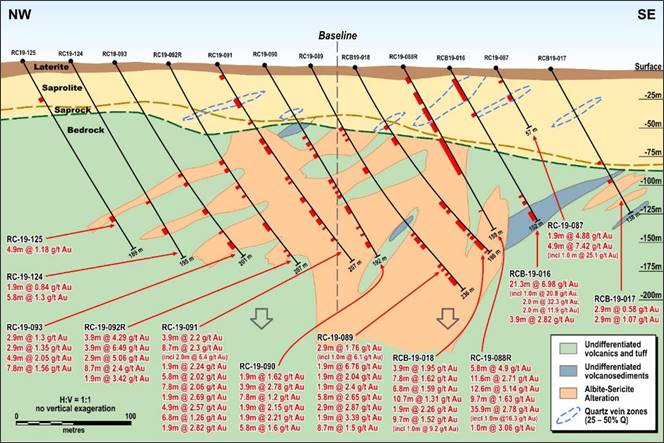
NEXT STEPS
- At least 90,000 meters of additional drilling are expected to be completed before year-end focusing on the Kari area and other highly ranked targets such as Vindaloo Deep and Grand Espoir.
- Maiden resource and reserve estimates are expected to be published for the Kari Center and Kari West discoveries in Q4-2019.
- Metallurgical and geotechnical tests are already being conducted for both Kari Center and Kari West, and a dedicated Environmental Impact Assessment for the Kari area is underway.
- An updated mine plan and technical report, integrating Kari Pump, Center and West, are expected to be released following the publication of maiden reserves at the Kari West and Center discoveries.
QUALIFIED PERSONS
The scientific and technical content of this news release has been reviewed, verified and compiled by Gérard de Hert, EurGeol, Senior VP Exploration for Endeavour Mining. Gérard de Hert has more than 20 years of mineral exploration and mining experience, and is a "Qualified Person" as defined by National Instrument 43-101 – Standards of Disclosure for Mineral Projects ("NI 43-101").
ASSAYS AND QUALITY ASSURANCE/QUALITY CONTROL / DRILLING AND ASSAY PROCEDURES
Reverse Circulation drill samples were collected at 1-meter intervals using dual tube, percussion hammer with drop center bit. This same configuration was used on modified Aircore drills for regional drill programs.
Reverse Circulation and Aircore samples were split at the drill site using 1 tier or 3-tier riffle splitters based on bulk sample weight collected at the cyclone. The target was a 2-3 kg sample for Au analysis in addition to an equivalent backup reference sample. Bulk weights, analysis sample weights and reference sample weights were all recorded. All measures were employed to avoid collecting wet samples. However, if wet samples were generated the entire sample was dried and split using 1 tier and 3 tier splitting equipment. Representative samples for each interval were collected with a spear from the bulk sample bag and sieved into chip trays for geological logging and stored in a secure location.
Drill core (PQ, HQ and NQ size) samples were selected by geologists and cut in half with a diamond blade saw at the project site. Half of the core was retained in the core trays at the site for reference purposes. The average sample interval was approximately one meter in length and 2-3kg in weight.
All samples were transported by road to ALS Burkina SARL in Ouagadougou (Burkina Faso). A record of all stages of the sample transportation was documented for chain of custody purposes.
At the AlS-Chemex laboratory sample preparation includes, crushing the entire sample to 2mm at 80% passing and pulverizing a 1kg split to 75μm at 85% passing.
Samples were analyzed for gold using standard 50-gram charge fire assay with acid digestion and Atomic Absorption (AA) finish. Assay results over 5 and 10 g/t Au were analyzed by gravimetric and screen fire assay methods, respectively.
All aspects of sampling at the Kari Area project site were monitored with a quality assurance –quality control (QA-QC) program, compliant with NI 43-101 standards. This to ensure there are adequate internal quality control samples in each analytical batch: coarse blanks, field duplicates and certified reference material (CRM) were inserted by geologists into the sample stream for verification of the analysis at the laboratory. QAQC sample Insertion rates include: one Blank, one Field Duplicate and one CRM each 30 samples in regional Air Core programs, one Blank, one Field Duplicate and one CRM each 25 samples in Reverse Circulation delineation drilling and one Blank and one CRM each 20-25 samples in diamond core sample sequences. In addition the laboratory was contracted to generate 1 coarse crush duplicate and one pulp duplicate each 60 samples for regional Aircore programs, each 50 samples for Reverse Circulation delineation drilling and each 40 samples in diamond core sample sequences.
Kari Area drill and QA-QC programs were audited by external consultants in February and May 2019. The primary laboratory was audited in June 2018.
Click here to view the 2019 completed drill results on the Kari target.
CONTACT INFORMATION
Martino De Ciccio
VP – Strategy & Investor Relations
+44 203 640 8665
mdeciccio@endeavourmining.com | Brunswick Group LLP in London
Carole Cable, Partner
+44 7974 982 458
ccable@brunswickgroup.com |
ABOUT ENDEAVOUR MINING CORPORATION
Endeavour Mining is a TSX listed intermediate African gold producer with a solid track record of operational excellence, project development and exploration in the highly prospective Birimian greenstone belt in West Africa. Endeavour is focused on offering both near-term and long-term growth opportunities with its project pipeline and its exploration strategy, while generating immediate cash flow from its operations.
Endeavour operates 4 mines across Côte d’Ivoire (Agbaou and Ity) and Burkina Faso (Houndé, Karma) which are expected to produce 615-695koz in 2019 at an AISC of $760-810/oz.
For more information, please visit www.endeavourmining.com.
Corporate Office: 5 Young St, Kensington, London W8 5EH, UK
This news release contains "forward-looking statements" including but not limited to, statements with respect to Endeavour's plans and operating performance, the estimation of mineral reserves and resources, the timing and amount of estimated future production, costs of future production, future capital expenditures, and the success of exploration activities. Generally, these forward-looking statements can be identified by the use of forward-looking terminology such as "expects", "expected", "budgeted", "forecasts", and "anticipates". Forward-looking statements, while based on management's best estimates and assumptions, are subject to risks and uncertainties that may cause actual results to be materially different from those expressed or implied by such forward-looking statements, including but not limited to: risks related to the successful integration of acquisitions; risks related to international operations; risks related to general economic conditions and credit availability, actual results of current exploration activities, unanticipated reclamation expenses; changes in project parameters as plans continue to be refined; fluctuations in prices of metals including gold; fluctuations in foreign currency exchange rates, increases in market prices of mining consumables, possible variations in ore reserves, grade or recovery rates; failure of plant, equipment or processes to operate as anticipated; accidents, labour disputes, title disputes, claims and limitations on insurance coverage and other risks of the mining industry; delays in the completion of development or construction activities, changes in national and local government regulation of mining operations, tax rules and regulations, and political and economic developments in countries in which Endeavour operates. Although Endeavour has attempted to identify important factors that could cause actual results to differ materially from those contained in forward-looking statements, there may be other factors that cause results not to be as anticipated, estimated or intended. There can be no assurance that such statements will prove to be accurate, as actual results and future events could differ materially from those anticipated in such statements. Accordingly, readers should not place undue reliance on forward-looking statements. Please refer to Endeavour's most recent Annual Information Form filed under its profile at www.sedar.com for further information respecting the risks affecting Endeavour and its business. AISC, all-in sustaining costs at the mine level, cash costs, operating EBITDA, all-in sustaining margin, free cash flow, net free cash flow, free cash flow per share, net debt, and adjusted earnings are non-GAAP financial performance measures with no standard meaning under IFRS, further discussed in the section Non-GAAP Measures in the most recently filed Management Discussion and Analysis.

Figure 1 - Simplified Houndé Exploration Targets Map
Figure 1 - Simplified Houndé Exploration Targets Map
Figure 2 - Kari Area 2019 Drilling
Figure 2 - Kari Area 2019 Drilling
Figure 3 - Simplified Houndé Mineralization Map
Figure 3 - Simplified Houndé Mineralization Map
Figure 4 - Kari Pump Extension Drilling and Selected Intercepts
Figure 4 - Kari Pump Extension Drilling and Selected Intercepts
Figure 5 - Kari Center Main and South with Selected Intercepts
Figure 5 - Kari Center Main and South with Selected Intercepts
Figure 6 - Kari Center Main Section
Figure 6 - Kari Center Main Section
Figure 7 - Kari West Drill Map with Selected Intercepts
Figure 7 - Kari West Drill Map with Selected Intercepts
Figure 8 - Kari West Drill Section
Figure 8 - Kari West Drill Section